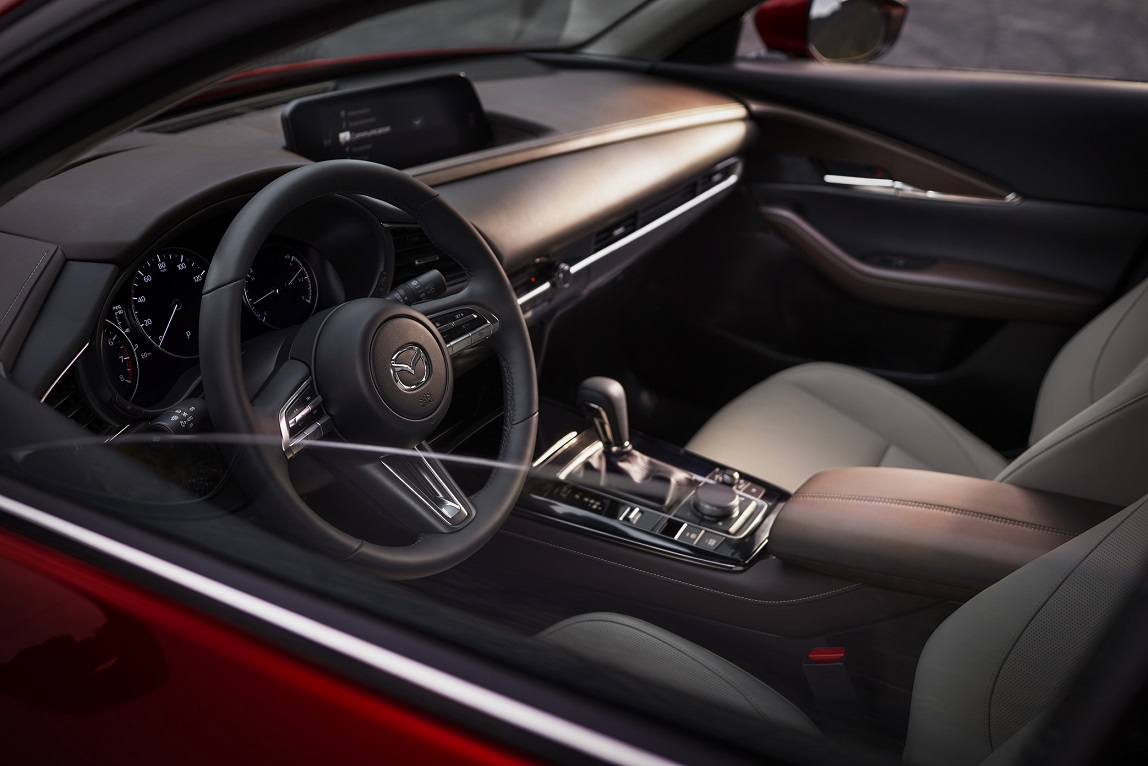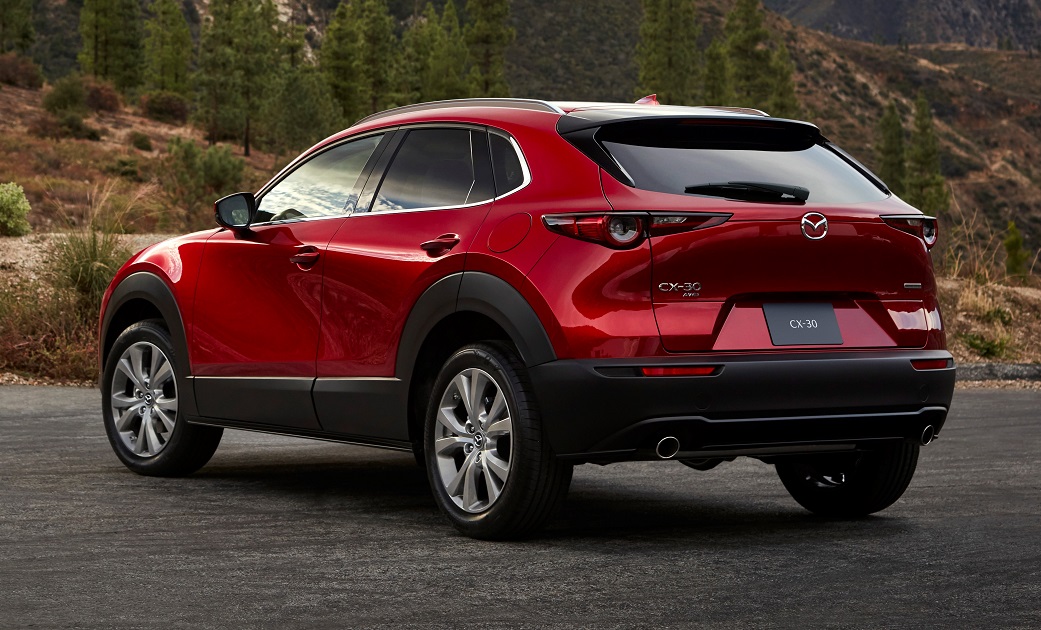LOS ANGELES – If you’re young and getting ready to start a family, or you’re an empty-nester looking to downsize, Mazda has what it thinks is the perfect vehicle for you.
The ’20 Mazda CX-30 is based on the same platform and powertrains used in the recently redesigned Mazda3 but takes the form of a subcompact CUV with more room for people and cargo than the cramped Mazda CX-3.
The new CX-30 debuts at the 2019 Los Angeles auto show. When it goes on sale in December, it will come in standard, Select, Preferred and Premium trim levels. Prices start at $21,900, plus $1,045 for destination. The CX-30 Premium with all-wheel drive goes for $29,600 plus destination.
So what’s the deal with the name? Naohito Saga, program manager for the CX-30, says the automaker is embarking on a new naming strategy for its vehicles. As they are redesigned or newly introduced, they’ll adopt the new nomenclature.
The Mazda CX-30 is the first of Mazda’s crossovers to get the change. Larger than the CX-3 and smaller than the CX-5, the CX-30 is a subcompact model in the U.S. market (and a compact globally).
The second vehicle after the Mazda3 to adopt the latest evolution of the automaker’s Kodo design theme, the CX-30 has the “flowing beauty of a coupe” (below) combined with “the bold proportions of an SUV.” Like other Mazdas, it is appealing, but the excessive gray lower-body cladding makes the crossover’s wheels look too small.

Every CX-30 except for the base trim is equipped with 18-in. aluminum wheels and dark-tinted rear privacy glass. Preferred trim adds a gloss black finish on the grille, while Premium specification adds roof rails, a power sunroof and LED headlights and taillights.
Under the CX-30’s jutting hood, Mazda’s familiar Skyactiv-G 2.5L 4-cyl. gives this CUV impressive power. The engine makes 186 hp and 186 lb.-ft. (252 Nm) of torque, plenty for a vehicle that weighs 3,408 lbs. (1,547 kg) in Premium AWD guise. Premium trim includes fuel-saving cylinder-deactivation technology, and while fuel-economy numbers aren’t final, in the Mazda3 hatchback this same engine delivers between 27 mpg and 29 mpg (8.7-8.1 L/100 km), depending on the drivetrain.
A 6-speed automatic transmission is standard with the CX-30, good news for people who dislike continuously variable transmissions, and it includes paddle shifters in Premium trim.
It delivers power to the front wheels unless the CX-30 has the optional predictive i-Activ all-wheel-drive system ($1,400). What makes it predictive? New off-road traction assist technology that redistributes power from the wheels that are slipping to the wheels that are gripping.
Mazda’s G-Vectoring Control Plus technology aids handling and reduces the impact of ride motion on the driver and passengers. Technically, the CX-30 seats five people, but four will be happier. Cloth upholstery is standard, with leatherette in the Select and Preferred trims and leather in the CX-30 Premium.
The Premium’s 8-way power-adjustable driver’s seat is exceptionally comfortable. When it’s moved all the way back, a 6-ft.-tall (1.8-m) person will need to squeeze into the back seat, but once they’re in the cushion itself proves supportive and the soft front seatback material is kind to knees and shins.
Mazda CX-30 cargo space measures 20.2 cu.-ft. (572 L) behind the rear seat. The space is conveniently shaped, though the young families Mazda hopes to attract might find it hard to get a compact folding stroller in lengthwise.
The CX-30 Premium’s interior (below) reflects the sense of style and materials quality we’ve come to expect from the automaker, and it feels larger than it is from the driver’s seat. This is due, in part, to Mazda’s use of an open-cabin concept with a low center console and horizontal design elements. A high driving position and relatively thin A-pillars also help.

Mazda claims to have minimized interior noise, vibration and harshness, especially with regard to road noise. The company also has fine-tuned stereo speaker placement to provide rich bass without buzzing or rattling.
Driver-centric instrumentation and controls aim to reduce distraction and limit eye movement. Saga explains Mazda’s human-centered design philosophy is why the latest version of the automaker’s Mazda Connect infotainment system does not offer a touchscreen.
Instead, owners use the hard controls on the center console, steering-wheel controls or voice commands. The system does not, however, respond to natural voice commands.
Measuring 8.8 ins. (22 cm) wide, the Mazda Connect display is embedded into the top of the CX-30's dashboard for a clean look and is canted toward the driver for easy reference. It includes Bluetooth, HD Radio, eight speakers and new Mazda Connected Services technology.
Upgrade to Select trim and Mazda Connect adds Apple CarPlay and Android Auto smartphone integration. Preferred trim adds a premium 12-speaker Bose audio system and satellite radio.
Every Mazda CX-30 is equipped with the company’s i-Activsense suite of advanced driving assistance systems. They include adaptive cruise control with stop-and-go capability, forward collision warning, automatic emergency braking, lane departure warning, lane-keeping assist, automatic high-beam headlights and a driver monitoring system.
Select trim adds a blindspot monitoring system with rear cross-traffic alert, while Premium trim includes adaptive headlights and an Active Driving head-up display.
As Saga explains during our interview at the auto show, Mazda’s goal was to build a vehicle people wanted rather than simply needed. Based on first impressions, the automaker achieves that mission with the new ’20 Mazda CX-30.






